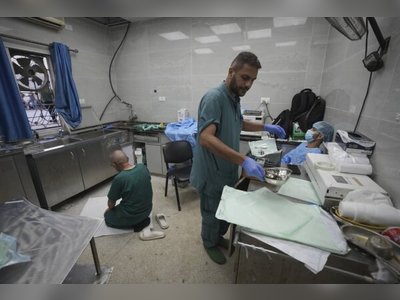
Saudi Arabia Sets Ambitious Goal to Reduce National Unemployment Rate to Record Low of 5 Percent by 2030
Ministry of Human Resources and Social Development revises target amid accelerated labor market reforms.
JEDDAH: Saudi Arabia's labor market is experiencing a transformative shift, with the Kingdom achieving record lows in unemployment among its nationals.
The Ministry of Human Resources and Social Development (MHRSD) has revised its national employment target, aiming to reduce the unemployment rate to 5 percent by 2030, six years ahead of schedule.
Minister Ahmed Al-Rajhi announced during the Budget Forum 2024 that the previous goal of lowering Saudi Arabia's unemployment among nationals to 7 percent by 2030 has been surpassed.
The unemployment rate, which stood at 12.8 percent in 2018, has now dropped to 7.1 percent.
As a result, Crown Prince Mohammed bin Salman directed a review of this target, resulting in the new ambition to achieve an unprecedented 5 percent unemployment rate by 2030.
The latest data from the General Authority for Statistics (GASTAT) reflects continued progress in this direction, with the national unemployment rate falling to 6.3 percent in the first quarter of 2025 — the lowest level on record.
Labor force participation among Saudis rose to 51.3 percent, with notable gains among women and core working-age citizens.
A significant achievement highlighted by Al-Rajhi is the surge in female economic participation, which has reached 35 percent, surpassing the Vision 2030 target of 30 percent by 2030.
GASTAT data supports this trajectory, showing a female labor force participation rate of 36.3 percent, while the unemployment rate among Saudi women declined to 10.5 percent.
The success in reducing unemployment is attributed to comprehensive labor reforms and national transformation initiatives.
These include robust economic policies, strategic government initiatives, and sustained labor market reforms.
Key enablers include the Human Capability Development Program, the decline in female unemployment, and large-scale giga-projects such as NEOM, Qiddiya, Red Sea Project, and Diriyah Gate, which are entering high-employment phases.
The MHRSD has implemented 84 percent of the Labor Market Strategy over four years, creating 300,000 jobs in specialized professions.
The Waad National Training Program, launched in partnership with the private sector, has provided over 1.3 million training opportunities to equip Saudis with practical skills aligned to labor market needs.
To support these changes, the Ministry of Human Resources and Social Development has modernized labor regulations, amending more than 38 articles to enhance workforce flexibility and protection.
New insurance products have been introduced to safeguard employers and employees.
Additionally, a shift toward digital engagement and more efficient job searches is evident, with 75.8 percent of job seekers approaching employers directly and 64.5 percent updating their resumes on professional social media.
Looking ahead, further progress requires a holistic approach that encourages greater private sector employment beyond Saudization policies.
Improving the alignment between education outcomes and labor market requirements will be critical to ensuring that graduates possess the skills demanded by the private sector.
The integration of emerging technologies into curricula and collaboration with industry leaders can help bridge the gap between education and employment, preparing students for the demands of the modern workforce.
Saudi Arabia's focus on evidence-based research, innovation, and targeted workforce development is crucial to address the persistent mismatch between graduates' qualifications and labor market requirements.
This transition aims to ensure that the national workforce is equipped with the skills and expertise needed to thrive in a dynamic, diversified economy.
The Ministry of Human Resources and Social Development (MHRSD) has revised its national employment target, aiming to reduce the unemployment rate to 5 percent by 2030, six years ahead of schedule.
Minister Ahmed Al-Rajhi announced during the Budget Forum 2024 that the previous goal of lowering Saudi Arabia's unemployment among nationals to 7 percent by 2030 has been surpassed.
The unemployment rate, which stood at 12.8 percent in 2018, has now dropped to 7.1 percent.
As a result, Crown Prince Mohammed bin Salman directed a review of this target, resulting in the new ambition to achieve an unprecedented 5 percent unemployment rate by 2030.
The latest data from the General Authority for Statistics (GASTAT) reflects continued progress in this direction, with the national unemployment rate falling to 6.3 percent in the first quarter of 2025 — the lowest level on record.
Labor force participation among Saudis rose to 51.3 percent, with notable gains among women and core working-age citizens.
A significant achievement highlighted by Al-Rajhi is the surge in female economic participation, which has reached 35 percent, surpassing the Vision 2030 target of 30 percent by 2030.
GASTAT data supports this trajectory, showing a female labor force participation rate of 36.3 percent, while the unemployment rate among Saudi women declined to 10.5 percent.
The success in reducing unemployment is attributed to comprehensive labor reforms and national transformation initiatives.
These include robust economic policies, strategic government initiatives, and sustained labor market reforms.
Key enablers include the Human Capability Development Program, the decline in female unemployment, and large-scale giga-projects such as NEOM, Qiddiya, Red Sea Project, and Diriyah Gate, which are entering high-employment phases.
The MHRSD has implemented 84 percent of the Labor Market Strategy over four years, creating 300,000 jobs in specialized professions.
The Waad National Training Program, launched in partnership with the private sector, has provided over 1.3 million training opportunities to equip Saudis with practical skills aligned to labor market needs.
To support these changes, the Ministry of Human Resources and Social Development has modernized labor regulations, amending more than 38 articles to enhance workforce flexibility and protection.
New insurance products have been introduced to safeguard employers and employees.
Additionally, a shift toward digital engagement and more efficient job searches is evident, with 75.8 percent of job seekers approaching employers directly and 64.5 percent updating their resumes on professional social media.
Looking ahead, further progress requires a holistic approach that encourages greater private sector employment beyond Saudization policies.
Improving the alignment between education outcomes and labor market requirements will be critical to ensuring that graduates possess the skills demanded by the private sector.
The integration of emerging technologies into curricula and collaboration with industry leaders can help bridge the gap between education and employment, preparing students for the demands of the modern workforce.
Saudi Arabia's focus on evidence-based research, innovation, and targeted workforce development is crucial to address the persistent mismatch between graduates' qualifications and labor market requirements.
This transition aims to ensure that the national workforce is equipped with the skills and expertise needed to thrive in a dynamic, diversified economy.










